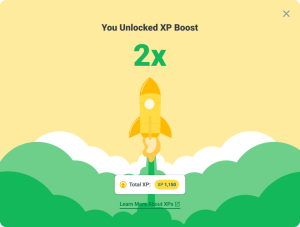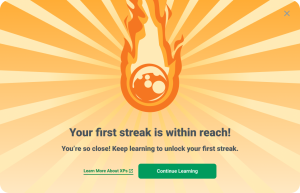Disengaged learners cost organisations millions in lost productivity, higher turnover, and stalled capability growth. According to Gallup, employee disengagement costs the global economy $8.8 trillion annually, equivalent to 9% of global GDP. The good news? Companies that embed gamification into their L&D programmes report 25%+ higher engagement, stronger knowledge retention, and faster upskilling. By turning learning into an active, rewarding experience, gamification doesn’t just increase participation; it delivers a measurable business advantage.
At Alison, we recently conducted a beta test involving 56K+ users on our new gamified platform. This real-world test measured exactly how gamification impacted learning outcomes, and the results speak volumes.
What Is Gamified Learning?
Gamified learning refers to the use of game-like elements, such as points, badges, leaderboards, and progress streaks, within a digital learning environment. When integrated into a Learning Management System (LMS), these elements encourage consistent learner participation and reinforce positive behaviours.
Gamification isn’t just about adding fun for fun’s sake. It’s rooted in cognitive and motivational science, designed to create psychological incentives that keep learners coming back.
For example, a sales team using a gamified LMS might earn badges for completing product modules, see their names rise on a leaderboard for high quiz scores, and maintain a learning streak that unlocks bonus content, turning daily training into a friendly, rewarding competition.
The Solution: Gamification in Learning Management Systems
To address the persistent challenges of disengagement, low retention, and high drop-off rates, Alison integrated game mechanics directly into its LMS+, its Learning Management System.
In our beta programme, we introduced three key features:

- Experience Points (XP): Learners earned XP for completing modules and quizzes, offering immediate, tangible rewards for progress.
- Leaderboards: Ranking systems created friendly competition among users, energising learners through visible achievement and team dynamics.
- Streaks: Daily participation streaks reinforced habit formation and rewarded learners for consistent effort.
These elements weren’t superficial add-ons. They were intentionally designed to align with motivational triggers and reduce friction in the learning journey. Together, they formed a scalable, free gamification platform built to improve both learner experience and business outcomes.
Incorporating these into your workplace gamification strategies enables scalable L&D innovation while aligning training with behavioural science principles.
By implementing these mechanics, Alison created a real-world example of LMS gamification lessons in action, illustrating how strategic design can radically shift user behaviour and performance.
Real Results from 56K+ Learners
Our beta test engaged over 56,000 learners. The performance gains were measurable and significant:
- Study time increased by 25.6%
- Number of sessions rose by 21.3%
- Course completions increased by 12.3%
- Average time per learner grew by 5.2%
These improvements were observed across regions, industries, and job roles, demonstrating that gamification in learning can deliver consistent results at scale.
Why Gamification in Learning Works
Gamification succeeds because it reflects how people are wired to respond to progress, recognition, and challenge. It connects psychological drivers to educational design.
- XP feeds the need for accomplishment. Seeing a progress bar move or watching a point total grow creates a real sense of momentum, even in small steps, which keeps learners engaged.
- Leaderboards tap into social motivation. When learners see their efforts reflected in rankings, even anonymously, they feel a deeper investment in outcomes.
- Streaks encourage consistency. Repeated actions over time form habits. By recognising consecutive days of learning, streaks make the process feel natural and worth sustaining.
 In post-test feedback, learners shared how these features transformed their behaviour. Some returned “just to keep the streak alive.” Others admitted that the XP system nudged them into finishing courses they might have otherwise dropped. What began as a novelty quickly became motivation.
In post-test feedback, learners shared how these features transformed their behaviour. Some returned “just to keep the streak alive.” Others admitted that the XP system nudged them into finishing courses they might have otherwise dropped. What began as a novelty quickly became motivation.
These results reinforce that, but because it’s built on a strong behavioural foundation. It aligns what learners want, clear goals, progress, and reward, with what organisations need: participation, retention, and outcomes.
What This Means for L&D Teams
For Learning & Development leaders, the implications are clear:
- Gamification reduces drop-off and increases course completion.
- It’s scalable across teams, departments, and geographies.
- Built-in engagement mechanics lower administrative overhead.
- Real-time analytics provide clear data on learner performance.
With gamification, training stops being something that needs reminders or follow-ups. Learners are more likely to return, participate, and complete without extra prompting, freeing up L&D teams to focus on strategy, not chasing completions.
How to Implement Gamified Learning in Your Organisation
To bring gamified learning to life in your workplace:
1. Use a platform with built-in gamification
Choose a learning platform like Alison’s LMS+ that includes XP, streaks, and leaderboards out of the box, no third-party tools or extra integrations required.
2. Align game mechanics with KPIs
Tie gamification to measurable goals like compliance, upskilling, or internal mobility. Use badges and XP to recognise real business milestones.
3. Communicate the why
Explain to learners how gamification benefits them, their career development, recognition, and overall learning outcomes.
4. Launch, track, and scale
Start small, gather data, and expand based on real engagement metrics. Use platform analytics to refine the approach and personalise future learning paths.
Conclusion: Gamified Learning Is More Than a Trend
Gamified learning isn’t just a buzzword. It’s a tested, psychology-backed approach to solving one of the biggest problems in corporate training: getting people to care enough to learn.
Done right, gamification fosters consistency, ownership, and motivation, without additional cost or complexity. And with Alison’s gamification platform, it’s now easier than ever to embed those benefits directly into your organisation’s learning strategy.
Discover how Alison’s LMS platform can make learning a priority for your team.
Additional Tools to Boost Workplace Learning
To further support employee development, explore these valuable tools and assessments:
Stay connected with us on LinkedIn for updates and success stories.









